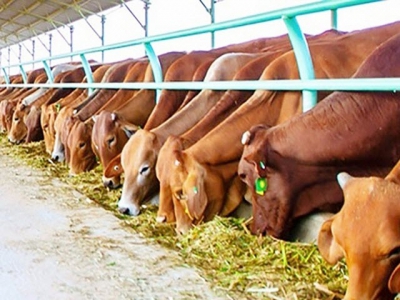Concerns about the high price of animal feed

Since the end of 2020, the price of animal feed ingredients has continuously increased, pushing the price of finished animal feed up. This has directly affected both feed production enterprises and livestock enterprises.
Many livestock enterprises are facing risks of loss, abandoning repopulation due to the "uncontrollable" increase in the price of animal feed. Photo: Internet
Risk of loss
According to the Ministry of Agriculture and Rural Development, one of the reasons why the price of imported animal feed ingredients as well as the price of finished animal feed continuously increases is that the prices of cereals on the global market have increased, setting a new price level.
This comes from rising production costs and climate change affecting crops. Moreover, large investment funds have shifted to speculating on agricultural products, and China increased the purchase of cereals for domestic production and animal husbandry. Besides, the lack of empty containers has also significantly affected goods transportation in general, including animal feed. The lack of containers has caused transportation costs to increase by 200-300% compared to normal price.
Talking to Customs News, Phi Van Diem, owner of a pig breeding facility in Ba Vi (Hanoi), said in the past, the price of animal feed was about VND230,000-280,000 per bag of 25-30kg (depending on type), now it has increased to nearly VND400,000 per bag.
“The increase in animal feed prices is not new but has happened since the end of last year. At that time, we still had food in reserve, so it was not affected. By February, when we started the new litter, the impact was bigger. Besides, due to the Covid-19 pandemic, the consumption of our livestock products has slowed down, and the selling price has many unpredictable fluctuations. This has a direct impact on the livestock production, pushing up production costs, making livestock businesses like us almost unprofitable, even losing after deducting all production costs. For large livestock enterprises with several thousand animals, the impact was much larger. Many livestock enterprises are facing the risk of losses and abandoning repopulation," said Diem.
From the perspective of a livestock enterprise, Phan Vinh Thanh, Director of Hung Thanh Agricultural Development Company Limited, said if the price of animal feed continued to increase, the company would lose 10-25% in this litter. Currently, they are implementing the optimal diet balance, while applying good management of raw materials and minimizing production costs to reduce costs, but the results are not satisfactory.
Overcoming difficulties with chain links
Regarding the dramatic increase in the price of animal feed ingredients by 40% compared to the end of last year, the Ministry of Agriculture and Rural Development suggested that animal feed manufacturers only increase the price of animal feed by 10-15% despite the sharp increase in raw material prices. However, this increase was still high and overwhelming for many livestock enterprises, especially in the context of continuous decreases in the price of poultry and live pigs.
Facing the continuous increase in the price of raw materials for animal feed, many feed manufacturers have considered options to be more proactive in domestic animal feed sources, reducing dependence on imported raw materials.
Accordingly, many large domestic enterprises such as Masan, Hoa Phat, Hung Vuong, and Vingroup began to make large investments in the animal feed industry to regain market share from foreign units. Hoa Phat Group has built and put into operation an animal feed processing factory in Long Khanh Industrial Park with a capacity of 200,000 tons per year. Masan has acquired the Vietnam - France Cattle Feed JSC (Proconco) and the International Agricultural Nutrition JSC (Anco). As a result, this company has become the second largest feed supplier in the country.
Nguyen Xuan Duong, acting director of the Department of Livestock Production (Ministry of Agriculture and Rural Development), said that to control the price and market, production and business establishments need to actively seek and make the most of domestic animal feed materials that can replace imported sources for animal feed processing (cashew nut oil, cashew bran, cassava residue, and rice bran).
Thanh suggested that in the future, the State should make a suitable support plan for livestock enterprises to overcome the current difficult period, especially when the Covid-19 pandemic has caused a decrease in the output of many livestock enterprises while the selling price of products has not increased.
According to Thanh, most small livestock enterprises will be the ones most affected due to the lack of links and the inability to share their risks, leading to losses.
“To overcome the crisis, we have been looking for opportunities to build a chain production cycle from feed production, barns, to product processing and trading. Small livestock enterprises joining the above chain model can share risks in all stages, ensuring that they will not suffer losses. This is also a business trend that small livestock units will follow in the future,” said Thanh.
Related news
 What are the corporate income tax incentives for pepper growing activities?
What are the corporate income tax incentives for pepper growing activities? The General Department of Taxation has just given feedback on the problems of a number of businesses recognized by the Research and Development Board
 Rice exporter to benefit from the Philippines' tariff reduction
Rice exporter to benefit from the Philippines' tariff reduction Rice imports to 35%, opening up opportunities for Vietnam, one of the major exporters of rice to the Philippines, to stabilize its rice supply for this country.
 Setting the target of 100% forestry and agricultural firms companies earn profit
Setting the target of 100% forestry and agricultural firms companies earn profit Target plan by 2025, one hundred percent of agriculture and forestry businesses completely solve all financial and land problems as well as earn profit.